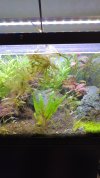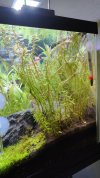I use river pebbles from the River Rhine, as I live 10min from the riverbanks. The river might be hardwater, the pebbles along are mostly granite and quarz-mix, which are inert. But to be honest... I barely use them. Right now there are maybe 5-8 in the tank, most between 5 and 10cm in diameter. The tank could very well go without them.Which stones would you suggest for a apistogramma aquarium (or any other fish that need soft water with a lower ph) or just no stones at all?
Yes, basically until they break apart, which takes decades. The softer/more acidic the water, the more is dissolved from them.Do seriyu rocks keep raising the GH & KH even after a long time being in the tank?
Clean tanks are dead tanks. I only clean the front glass, otherwise I leave the aufwuchs for the fish. Ad be it Nannostomus, Hemigrammus or Dicrossus, all of my fish love picking at it for food particles. Aufwuchs eaters that keep everything clean are the last thing I want, because then I'd have to feed more, especially when I'm gone for some days. Right now the tank is in a state, I can leave for a week and my fish sitter only has to top up with RO for evaporation.My nerite snails are 3 months in my tank with the cacatuoides. I like the way they keep your hardscape and glass clean tbh... I thought my tank with the macmasteri could only benefit from it too besides the otocinclus. I would buy some sort of snail sticks if I buy some nerite snails in the setup with the catappa leaves & softer water so they don't get soft shells & die because the water is too soft.
And no, Nerite snails and Otocinclus are competing for food. So please no more snails. They are simply not suited for these conditions.
Very sorry to say so: You've fallen into the classic trap at the store. (But no worries, everybody steps into one of them at one point at the beginning) You don't need algae eaters and if any, not from the start. Ever seen Otocinclus laborously slurping on any surface? They are often not feeding, but looking for food, that isn't there. If they do that on rather clean looking surfaces they are already in survival mode. Do you know how many Otocinclus a 60 Liter tank can sustain without permanent additional feeding? Two. In numbers 2. For a species appropriate group of ten you already need a 250 Liter+.The otocinclus are also 3 months in the tank but I've already had several deaths last month and a half.
(5 out of 8 died unfortunately) I do check if their white bellies are swollen so they get enough food, but the otocinclus where I had multiple deaths don't eat any food I give them such as blanched zuchini or algae wafers. The other 5 otocinclus in my new setup with the macmasteri eat both blanched zuchini & algae wafers.
My lfs told me that otocinclus are the best algae eaters to keep in small 60L tanks in combination with nerite snails. He said that other algae eaters might try to eat the eggs of the apistogramma's at night.
Plus, as I said, these species are not Algae eaters, they are Aufwuchs eaters. subtle but important difference. They need a combination of bacteria, infusoria, and some algae. Usually I'm not a brand person, but as there is no alternative to my knowledge: I'd get "BacterAE" by GlasGarten which is a powder for Biofilm growth on surfaces (not the intended use by the manufacturer, so just experiment with very small doses), which will be helping. Also "Protogen" by Hobby, which grows infusoria. Try half the dosage on the pack.
And yeah... about the eggs... of course nocturnal plecos will go for them. They are also mostly not strict vegetarians.
saltwater or freshwater cyclops? Or frozen? I mainly mentioned Artemia because they just sink at one point because they die off in freshwater. So frozen cyclops: Do it!I do feed my cacatuoides fry cyclops so maybe thats similar to artemia and will also create a layer for the otocinclus?
Last edited:

